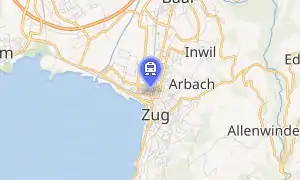Zug railway station
Zug railway station (German: Bahnhof Zug) serves the municipality of Zug, the capital city of the canton of Zug, Switzerland.
Zug | ||||||||||||||||||||||||||||||||||||||||||||||||||||||||||||||||||||||||||||||||
|---|---|---|---|---|---|---|---|---|---|---|---|---|---|---|---|---|---|---|---|---|---|---|---|---|---|---|---|---|---|---|---|---|---|---|---|---|---|---|---|---|---|---|---|---|---|---|---|---|---|---|---|---|---|---|---|---|---|---|---|---|---|---|---|---|---|---|---|---|---|---|---|---|---|---|---|---|---|---|---|---|
 Entrance to the 2001–2004 station building | ||||||||||||||||||||||||||||||||||||||||||||||||||||||||||||||||||||||||||||||||
| Location | Bahnhofplatz Zug Switzerland | |||||||||||||||||||||||||||||||||||||||||||||||||||||||||||||||||||||||||||||||
| Coordinates | 47°10′25.039″N 8°30′55.044″E | |||||||||||||||||||||||||||||||||||||||||||||||||||||||||||||||||||||||||||||||
| Elevation | 425 m (1,394 ft) | |||||||||||||||||||||||||||||||||||||||||||||||||||||||||||||||||||||||||||||||
| Owned by | Swiss Federal Railways | |||||||||||||||||||||||||||||||||||||||||||||||||||||||||||||||||||||||||||||||
| Line(s) | ||||||||||||||||||||||||||||||||||||||||||||||||||||||||||||||||||||||||||||||||
| Distance | 29.2 km (18.1 mi) from Zürich HB[1] | |||||||||||||||||||||||||||||||||||||||||||||||||||||||||||||||||||||||||||||||
| Platforms | 4 | |||||||||||||||||||||||||||||||||||||||||||||||||||||||||||||||||||||||||||||||
| Tracks | 7 | |||||||||||||||||||||||||||||||||||||||||||||||||||||||||||||||||||||||||||||||
| Train operators | ||||||||||||||||||||||||||||||||||||||||||||||||||||||||||||||||||||||||||||||||
| Connections | Zugerland Verkehrsbetriebe bus lines[2] | |||||||||||||||||||||||||||||||||||||||||||||||||||||||||||||||||||||||||||||||
| Construction | ||||||||||||||||||||||||||||||||||||||||||||||||||||||||||||||||||||||||||||||||
| Architect | Klaus Hornberger | |||||||||||||||||||||||||||||||||||||||||||||||||||||||||||||||||||||||||||||||
| Other information | ||||||||||||||||||||||||||||||||||||||||||||||||||||||||||||||||||||||||||||||||
| Fare zone | 610 (Tarifverbund Zug)[3] | |||||||||||||||||||||||||||||||||||||||||||||||||||||||||||||||||||||||||||||||
| History | ||||||||||||||||||||||||||||||||||||||||||||||||||||||||||||||||||||||||||||||||
| Opened | 1 June 1897 | |||||||||||||||||||||||||||||||||||||||||||||||||||||||||||||||||||||||||||||||
| Passengers | ||||||||||||||||||||||||||||||||||||||||||||||||||||||||||||||||||||||||||||||||
| 2018 | 46,500 per working day[4] | |||||||||||||||||||||||||||||||||||||||||||||||||||||||||||||||||||||||||||||||
| Services | ||||||||||||||||||||||||||||||||||||||||||||||||||||||||||||||||||||||||||||||||
| ||||||||||||||||||||||||||||||||||||||||||||||||||||||||||||||||||||||||||||||||
| Location | ||||||||||||||||||||||||||||||||||||||||||||||||||||||||||||||||||||||||||||||||

| ||||||||||||||||||||||||||||||||||||||||||||||||||||||||||||||||||||||||||||||||
Opened in 1897, the station is owned and operated by Swiss Federal Railways (SBB CFF FFS). It forms the junction between the Zürich–Lucerne railway and the Thalwil–Arth-Goldau railway, which connects with the Gotthard railway.[1]
Every day, some 46,000 people pass through the station.
Location
Zug railway station is situated in Bahnhofplatz, right in the heart of the city centre, a short distance from the shore of Lake Zug.
History
The first railway station in Zug was built in 1863-1864 by the architect Friedrich Jacob Wanner, in what is now the Bundesplatz. It was a terminal station, which could be reached only from the direction of Cham and Knonau. With an additional junction, trains could be turned. In 1897, as the railway lines to Zürich via Thalwil and to Arth-Goldau were opened, the station had to be moved to its current site. The original station building was dismantled and rebuilt in Zürich Wollishofen.
Station building
Between 2001 and 2004, a redesigned station building was constructed at the station, at a cost of some 65 million Swiss francs. The building area is approximately 6500 m².
The redesigned building consists of a basement used for storage, one retail space at street level and another at platform level, and three floors of office space above. A total of 14 retail stores are located in the retail spaces. A new passage to the station entrance was specially built, so that pedestrians can reach the concourse more easily. Additionally, the separate Grafenau and Metalli quarters are now easier to reach. For the cyclists, new shelters were built. The newly created Bahnhofsplatz serves as a bus turning area. There are also internet connections, via wireless LAN, at certain locations within the station.
From the onset of dusk until 23:00 hours, the station building is illuminated by a light installation by artist James Turrell. For that purpose, the southern glass facade is equipped with fluorescent tubes, which are mounted so that the colors red, green and blue and resulting mixed colors can be created. As the control system of the light elements can suffer technical problems during long-lasting cold weather, the installation is shut down in such weather.
On 19 October 2005, the station received a Brunel Award for its architecture and light installation.
Layout
The station has seven tracks, of which one is a terminating track, while the other six are through tracks. Altogether, there is a side platform and three island platforms, one of which is laid out in a wedge shape (tracks 3/4). One of the remaining island platforms is a partial side platform, due to the head track status of track 1.[5]
Summary of track usage:[6]
- Track 2: EuroCity/InterCity/InterRegio/Zug Stadtbahn S2 to Zürich Hauptbahnhof and Baar Lindenpark.
- Track 3: EuroCity/InterCity/InterRegio/Zug Stadtbahn S2 to Arth-Goldau, Erstfeld, and Ticino.
- Track 4: InterRegio/Lucerne S-Bahn S1/Zug Stadtbahn S1 to Rotkreuz, Lucerne, and Sursee.
- Track 5: InterRegio/Lucerne S-Bahn S1/Zug Stadtbahn S1 to Baar, Zürich Hauptbahnhof, and Konstanz.
- Track 6: Zürich S-Bahn S24 to Winterthur, Thayngen, and Weinfelden.
- Track 7: Zürich S-Bahn S5 to Pfäffikon SZ.
Services
As of the December 2020 timetable change, the following services call at Zug:[6]
- EuroCity: service every two hours between Zürich Hauptbahnhof and Milano Centrale.
- InterCity: service every two hours between Zürich Hauptbahnhof and Lugano.
- InterRegio:
- Lucerne S-Bahn S1/Zug Stadtbahn S1: service every fifteen minutes between Rotkreuz and Baar, with every other train continuing from Rotkreuz to Sursee.
- Zug Stadtbahn S2: hourly service between Baar Lindenpark and Erstfeld.
- Zürich S-Bahn:
- S5: half-hourly service to Pfäffikon SZ.
- S24: half-hourly service to Winterthur, trains continue from Winterthur to either Thayngen or Weinfelden.
Interchange
The station is the main hub of the Zug Stadtbahn, and is also part of the Zürich S-Bahn.
The Bahnhofplatz outside the station is a focal point of the extensive local public transport network of the Zugerland Verkehrsbetriebe (ZVB), which has 285 stops and a total route length of 197 km (122 mi).
References
- Eisenbahnatlas Schweiz. Cologne: Schweers + Wall. 2012. p. 22. ISBN 978-3-89494-130-7.
- "Liniennetzplan" (PDF) (in German). Zugerland Verkehrsbetriebe. 13 December 2020. p. 6. Retrieved 2 January 2021.
- "Tarifverbund Zug". Tarifverbund Zug. Retrieved 2 January 2021.
- "Passagierfrequenz (2018)". Berne, Switzerland: SBB CFF FFS. 7 October 2019. Retrieved 2019-11-06 – via data.sbb.ch – SBB DATA PORTAL.
- "Bahnhofpläne: Zug" (PDF). Swiss Federal Railways. July 2020. Retrieved 2 January 2021.
- "Abfahrt: Bahnhof Zug" (PDF). Swiss Federal Railways. 13 December 2020. Retrieved 2 January 2021.
External links
 Media related to Zug railway station at Wikimedia Commons
Media related to Zug railway station at Wikimedia Commons- Zug railway station – SBB
- Interactive station plan (Zug)